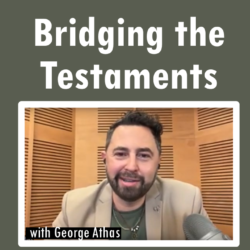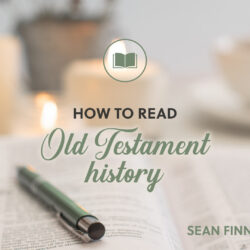This is part 10 of the Read the Bible For Yourself.
We’ve taken our time working through the Old Testament, section by section. Before we tackle the New Testament and look at the Gospels, we need to talk about the time between the Old and New Testaments. In the gap of roughly four hundred years, massive political and cultural changes occurred. Nowhere in the Old Testament do we see anything about the Romans, Pharisees, Sadducees, or the Sanhedrin. In today’s episode I’ll catch you up on what happened after the OT and before the NT so you can better understand the world in which Jesus functioned.
Listen to this episode on Spotify or Apple Podcasts
—— Links ——
- See other episodes in Read the Bible For Yourself
- Other classes are available here, including How We Got the Bible, which explores the manuscript transmission and translation of the Bible
- Get the transcript of this episode
- Support Restitutio by donating here
- Join our Restitutio Facebook Group and follow Sean Finnegan on Twitter @RestitutioSF
- Leave a voice message via SpeakPipe with questions or comments and we may play them out on the air
- Intro music: Good Vibes by MBB Attribution-ShareAlike 3.0 Unported (CC BY-SA 3.0) Free Download / Stream: Music promoted by Audio Library.
- Who is Sean Finnegan? Read his bio here
—— Notes ——
Recent History
- Persians: Cyrus the Great
- Greeks: Alexander the Great, Antiochus Epiphanes
- Hellenization (2 Maccabees 4.7, 10-15; 1 Maccabees 1.41-53)
- Maccabean Revolution: Mattathias, Judah the Maccabee, Jonathan Apphus, Simon Thassi, John Hyrcanus, Aristobulus I, Alexander Jannaeus, Salome Alexandra, Hyrcanus II, Aristobulus II
- Romans: Pompey the Great annexed Judea in 63bc
- Herodian Dynasty: Herod the Great and his descendants
Geographical and Political Setting
- Roman Empire: Augustus (27bc-ad14), Tiberius (14-37), Caligula (37-41), Claudius (41-54), Nero (54-68)
- Provinces: every region outside of Italy
- Galilee: Herod the Great (37-4bc), Herod Antipas (4bc-ad39), Herod Agrippa I (37-44)
- Judea: Herod the Great (37-4bc), Herod Archelaus (4bc-ad6), Coponius (6-9), Marcus Ambivulus (9-12), Annius Rufus (12-15), Valerius Gratus (15-26), Pontius Pilate (26-36), Marcellus (36-37), Marullus (37-41), Herod Agrippa I (41-44)
- Samaria: under Judean jurisdiction; Samaritans and Jews conflicted with each other
Jewish Groups
- Sadducees
- controlled the temple
- partners with Roman governors
- wealthy aristocrats
- chief priests were the leaders
- only accepted the Torah as scripture
- didn’t believe in resurrection or angels
- Pharisees
- focused on obedience to Torah
- accepted the law (Torah), prophets (Nevi’im), and writings (Kethuvim)
- oral tradition & fence laws
- not in power at the time of Jesus, except those in the Sanhedrin
- Sanhedrin
- Romans established 5 councils over 5 districts
- most important council was in Jerusalem
- had temple police at their disposal to arrest people
- could meet out punishments except capital punishment, which was reserved for the Roman governor
- Scribes
- every group had scribes
- even Paul used scribes to write his letters (Tertius in Rom 16.22)
- writing was a skill
- copy scripture to preserve it
- called lawyers or experts in the law
- Revolutionaries
- wanted to overthrow Roman occupation
- Josephus, Antiquities of the Jews23
“But of the fourth sect of Jewish philosophy, Judas the Galilean was the author. These men agree in all other things with the Pharisaic notions; but they have an inviolable attachment to liberty; and say that God is to be their only Ruler and Lord. They also do not value dying any kind of death, nor indeed do they heed the deaths of their relations and friends, nor can any such fear make them call any man Lord”
- John’s Renewal Movement
- called people to repent
- baptized them in the Jordan River
- possible connection with the Essenes
Important Issues
- Temple
- Taxes
- Torah
- Unrest
Review
- When the Greeks conquered the world, they made cities adopt their customs, culture, language, and religion.
- When Antiochus Epiphanes forcibly Hellenized Judah, it resulted in the Maccabean Revolution under Mattathias and his sons.
- After they won their independence, the Hasmonean Dynasty ruled up until 63bc when Pompey annexed Judea into the Roman Empire.
- Herod the Great and his descendants ruled over the region for many years, though in Judea the Romans directly ruled through governors.
- During Jesus’ ministry Herod Antipas ruled in Galilee and Pontius Pilate governed Judea and Samaria.
- Sadducees partnered with the Roman government and controlled the temple.
- The Pharisees focused on obedience to Torah, according to the traditions of the elders.
- The Sanhedrin was a council in Jerusalem made of Sadducees and Pharisees that controlled a police force and ruled on legal issues.
- Scribes copied scripture and had expert knowledge of the Law of Moses.
- Jesus lived in a time of fragile peace when Roman provocations threatened to light the match of Jewish revolution at any moment.







Thanks for this background explanation. It was pretty informative and I suspect this could really be done for 5-10 episodes and still wouldn’t cover it all.
I’ve been reading through some of the Geza Vermes “The Complete Dead Sea Scrolls” lately and seen more on the Essenes Community in the first chapter. Slowly getting through it, but they’re an interesting group. I find it highly ironic that in these writings, just like today with Christians—there are tons of factions of Hebrew religious believers zealous for God’s Torah all with various understandings, traditions, and communal principles to build their groups. The Community clearly believed they were in the “last days” though and the Kingdom of God was imminent writing around the time of 160BC – 70AD.
And in many senses I think you are at least a partial preterist Sean–or maybe you’ve always had this more historical understanding and I missed it. You could clarify your place of time separation in Matthew 24, but I only mention it cause you were so clearly saying Jesus predicted that temple destruction and he was right on. Jewish believers today still pray towards that former Temple location. It hasn’t changed much just like there’s still Samaritans today in Israel that Jews don’t like… but Jesus said it wouldn’t matter to the woman at the well where you worshipped God.